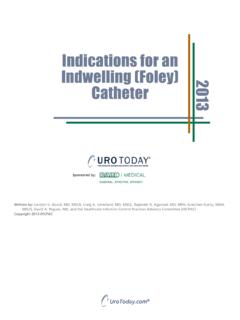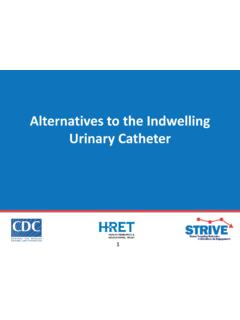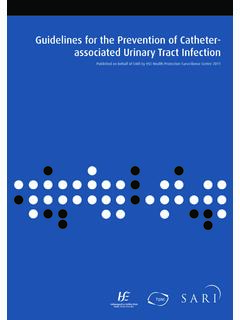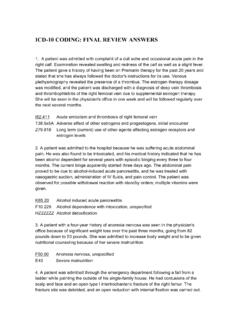Transcription of Foley Catheter Insertion and Removal Sample Procedure ...
1 BARD ADVANCE Foley TRAY SYSTEM. Foley Catheter Insertion and Removal Sample Procedure Purpose: To increase clinical knowledge of the BARD ADVANCE Foley Catheter Tray designed to follow the CDC Guidelines for Appropriate Indications for indwelling Urethral Catheter Use. This Sample Procedure is not intended as a replacement for the IFU. The end user bears the responsibility for including their own Procedure and protocol in practice. Supplies: BARD Advance Foley Catheter Tray Procedure : Foley Catheter Insertion 1. Confirm patient meets the CDC Guidelines for Appropriate Indications for indwelling Urethral Catheter Use a. Patient has acute urinary retention or bladder outlet obstruction b. Need for accurate urine output measurements c. Use for selected surgical procedures d. To assist in healing of open sacral or perineal wounds e.
2 Patient requires prolonged immobilization f. To improve comfort for end of life care 2. Select the smallest Foley Catheter possible, consistent with good drainage 3. Insert Foley Catheter using aseptic technique and sterile equipment a. Wash hands and don clean gloves b. Open outer CSR wrap and remove components c. Place underpad beneath patient, plastic or shiny side down d. Use the provided packet of castile soap wipes to cleanse patient's peri-urethral area e. Discard gloves and perform hand hygiene with provided alcohol hand sanitizer gel f. Don sterile gloves provided g. Position fenestrated drape on patient appropriately h. Use the syringe with the green plunger to deposit lubricant into tray top compartment for Foley Catheter lubrication i. Remove top tray and place next to bottom tray (keep on CSR wrap). j.
3 Attach the water-filled syringe to the inflation port (Note: It is not necessary to pre-test the Foley Catheter balloon). k. Remove Foley Catheter from wrap and lubricate Catheter l. Prepare patient with packet of pre-saturated antiseptic swab sticks 1) Female Patient: With a downward stroke cleanse the right labia minora and discard the swab, repeat for left labia minora, and with the last swab stick cleanse the middle area between the labia minora 2) Male Patient: Cleanse the penis in a circular motion starting at the urethral meatus and working outward m. Proceed with catheterization until urine is visible in the drainage tube, insert Catheter two more inches (or per hospital protocol), and inflate Catheter balloon using entire 10mL of Please consult product inserts and labels for any indications, contraindications, hazards, warnings, cautions and directions for use.
4 BARD AND STATLOCK are registered trademarks of C. R. Bard, Inc. For more information on clinical training & education programs contact 1208 66a sterile water provided in the prefilled syringe (Note: Use of less than 10mL can result in asymmetrically inflated balloon). n. Once inflated, gently pull Catheter until the inflated balloon is snug against the bladder neck o. Discard all materials in accordance with hospital protocol and remove contaminated gloves p. Perform hand hygiene 4. If provided, secure the Foley Catheter to the patient using the STATLOCK Foley Stabilization Device (Note: Please make sure patient is appropriate for use of STATLOCK device). 5. Position hanger on bed rail at the foot of the bed and use green sheeting clip to secure drainage tube to sheet, confirm tube is not kinked 6. Indicate time and date of Catheter Insertion on provided labels and place designated labels on patient chart and drainage system 7.
5 Document Procedure according to hospital protocol 8. Provide patient/family member Foley Catheter education to encourage them to take active role in preventing Catheter -associated urinary tract infections, document education according to hospital protocol Procedure : Foley Catheter Removal 1. Explain the Procedure to the patient and ensure privacy 2. Conduct a 15-30 second antiseptic hand wash 3. Don clean gloves 4. Remove STATLOCK Foley device 5. Position patient and place waterproof pad under patient 6. To deflate Catheter balloon: Back off luer lock or slip tip syringe to and insert into the inflation port. Allow the pressure within the balloon to force the plunger back and fill the syringe with water (if slow or no deflation is noticed, re-seat the syringe gently). 7. Use only gentle aspiration to encourage deflation if needed as vigorous aspiration may collapse the inflation lumen, preventing balloon deflation 8.
6 If the balloon will not deflate and if permitted by hospital protocol, the valve arm may be severed. If this fails, contact adequately trained professional for assistance, as directed by hospital protocol 9. Should balloon rupture occur, care should be take to assure that all balloon fragments have been removed from the patient 10. Remove the Catheter , discard it and document Procedure according to hospital policy Please consult product inserts and labels for any indications, contraindications, hazards, warnings, cautions and directions for use. BARD AND STATLOCK are registered trademarks of C. R. Bard, Inc. For more information on clinical training & education programs contact 1208 66a





